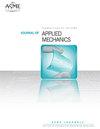Bioinspired Fiber Networks with Tunable Mechanical Properties by Additive Manufacturing
IF 2.8
4区 工程技术
Q2 MECHANICS
引用次数: 0
Abstract
Soft bioinspired fiber networks offer great potential in biomedical engineering and material design due to their adjustable mechanical behaviors. However, existing strategies to integrate modeling and manufacturing of bioinspired networks do not consider the intrinsic microstructural disorder of biopolymer networks, which limits the ability to tune their mechanical properties. To fill in this gap, we developed a method to generate computer models of aperiodic fiber networks mimicking type I collagen ready to be submitted for additive manufacturing. The models of fiber networks were created in a scripting language wherein key geometric features like connectivity, fiber length, and fiber cross section could be easily tuned to achieve desired mechanical behavior, namely pretension induced shear stiffening. The stiffening was first predicted using finite element software, and then a representative network was fabricated using a commercial 3D printer based on digital light processing technology using a soft resin. The stiffening response of the fabricated network was verified experimentally on a novel test device capable of testing the shear modulus of the specimen under varying levels of uniaxial pretension. The resulting data demonstrated clear pretension-induced stiffening in shear in the fabricated network, with uniaxial pretension of 40% resulting in a factor of 2.65 increase in the small strain shear modulus. The strategy described in this manuscript addresses the challenges in modeling bioinspired fiber networks and can be readily integrated with the advances in fabrication technology to fabricate materials truly replicating the mechanical response of biopolymer networks.增材制造具有可调谐机械性能的仿生纤维网络
柔性仿生纤维网络由于其可调节的力学行为,在生物医学工程和材料设计中具有巨大的潜力。然而,现有的集成仿生网络建模和制造的策略没有考虑生物聚合物网络固有的微观结构紊乱,这限制了调节其机械性能的能力。为了填补这一空白,我们开发了一种方法来生成模拟I型胶原的非周期性纤维网络的计算机模型,准备提交用于增材制造。纤维网络的模型是用脚本语言创建的,其中连接、纤维长度和纤维横截面等关键几何特征可以很容易地进行调整,以实现所需的机械性能,即预张力诱导的剪切硬化。首先使用有限元软件预测硬化,然后使用基于数字光处理技术的商用3D打印机使用软树脂制造具有代表性的网络。在一种新型试验装置上对预制网络的刚度响应进行了实验验证,该装置能够在不同水平的单轴预张力下测试试样的剪切模量。所得数据表明,预制网络中明显的预张力引起的剪切硬化,40%的单轴预张力导致小应变剪切模量增加2.65倍。本文中描述的策略解决了生物启发纤维网络建模的挑战,并且可以很容易地与制造技术的进步相结合,以制造真正复制生物聚合物网络机械响应的材料。
本文章由计算机程序翻译,如有差异,请以英文原文为准。
求助全文
约1分钟内获得全文
求助全文
来源期刊
CiteScore
4.80
自引率
3.80%
发文量
95
审稿时长
5.8 months
期刊介绍:
All areas of theoretical and applied mechanics including, but not limited to: Aerodynamics; Aeroelasticity; Biomechanics; Boundary layers; Composite materials; Computational mechanics; Constitutive modeling of materials; Dynamics; Elasticity; Experimental mechanics; Flow and fracture; Heat transport in fluid flows; Hydraulics; Impact; Internal flow; Mechanical properties of materials; Mechanics of shocks; Micromechanics; Nanomechanics; Plasticity; Stress analysis; Structures; Thermodynamics of materials and in flowing fluids; Thermo-mechanics; Turbulence; Vibration; Wave propagation

 求助内容:
求助内容: 应助结果提醒方式:
应助结果提醒方式:


